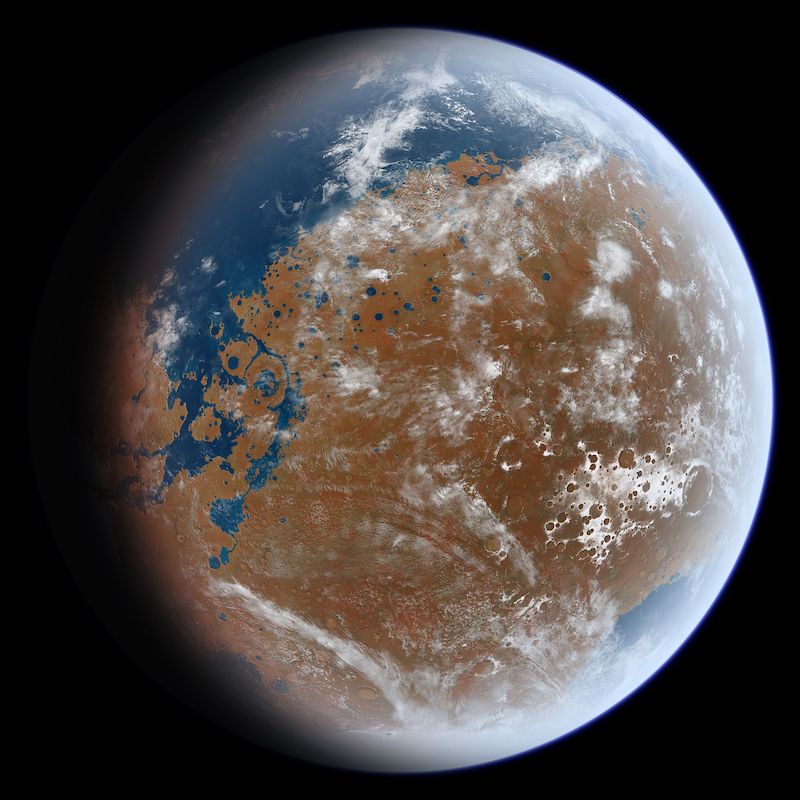
We know that Mars had rivers and lakes in the distant past. But what about oceans? There is indeed tentative evidence for an ancient ocean in the northern hemisphere. However, scientists have been debating that evidence for decades. But now, researchers in China and the U.S. say they have found new clues in marine sedimentary rocks in Utopia Planitia that may prove the existence of that ocean. China’s Zhurong rover discovered the sedimentary formations. The researchers announced the tantalizing findings in Science China Press on May 21, 2023.
Professor Long Xiao from the School of Earth Sciences at China University of Geosciences led the research team. The team published its accepted peer-reviewed paper in National Science Review on May 18, 2023. The paper, still undergoing final editing, is available as a PDF.
New evidence for ancient ocean on Mars
China’s Zhurong rover has been exploring its landing site on the southern edge of Utopia Planitia in the northern hemisphere of Mars. This is within the northern lowlands that some scientists say was likely once an ocean floor. The rover’s newest findings now bolster that possibility. The rover has been studying the rocks in the area with its multispectral camera (MSCam), and the science team says that Zhurong has found marine sedimentary rocks. While most other data supporting the ocean hypothesis has come from orbiting spacecraft, this new data is in situ (on site).
It is the Vasitas Borealis Formation (VBF) that the mission scientists interpret to be marine sedimentary rocks. As the paper explains:
Decades of research using remotely-sensed data have extracted evidence for the presence of an ocean in the northern lowlands of Mars in the Hesperian, but these claims have remained controversial due to the lack of in situ analysis of the associated geologic unit, the Vastitas Borealis Formation (VBF). The Tianwen-1/Zhurong rover was targeted to land within the VBF near its southern margin and has traversed almost 1.2 miles (2 km) southward toward the interpreted shoreline. We report here on the first in situ analysis of the VBF that reveals sedimentary structures and features in surface rocks that suggest that the VBF was deposited in a marine environment, providing direct support for the existence of an ancient (Hesperian) ocean on Mars.
Multispectral images provide clues
Zhurong has been gradually moving south toward what is thought to be an ancient coastline. The rover has taken 106 panoramic images so far during its travels. Mission scientists have been studying the multispectral images for clues about the rocks’ composition and origin. They found bedding structures that are different from the usual volcanic rock deposits on Mars.
In addition, they were different from rock formations created by blowing sand.

A shallow sea environment
Indeed, the images revealed bidirectional flow, a sign of possible low-energy tidal currents. They are similar to formations created in shallow marine environments on Earth. The mission team named this region the Zhurong Member. The rocks feature small-scale cross-bedding, lens-shaped flaser bedding and small channel structures.
The paper says:
Bidirectional current orientations are characteristically formed by regular opposite directions of tidal currents in terrestrial shallow marine environments, and uncommonly in fluvial environments. Although aeolian deposits on Mars also contain some small-scale cross-laminations, the lack of larger structures indicative of aeolian environments supports the interpretation that these are of shallow marine origin.
The images also showed that the layers in the cross-bedding overlap and tilt in two opposite directions. The thickness of the strata, as well as the size of sand grains, also differs. This is evidence for a bidirectional water flow pattern. On Earth, this is common in littoral-shallow sea environments.
Ancient shorelines of an ocean on Mars and a wild river
Last year, researchers at Penn State and Caltech said they discovered definitive traces of an old shoreline in Mars’ northern hemisphere.
And just last week, scientists announced that the Perseverance rover has found evidence for a rollicking river. It was the deepest and fastest-flowing river yet observed – now all dried up of course – by any rover or lander.
The new findings from the Zhurong rover would seem to support this, adding another crucial piece to the puzzle. That ocean would have been vast, covering most of the northern hemisphere of Mars. The next question, of course, is whether it supported any kind of life. It will be interesting to see what else Zhurong finds in its travels, as well as any future missions to this now-dry ocean wonderland.
Bottom line: Scientists in China say that the Zhurong rover has found new evidence for an ancient ocean on Mars, sedimentary rocks formed in a shallow marine environment. The ocean would have covered hundreds of thousands of square kilometers. They estimate the ancient Martian shoreline to be 3.5 billion years old.
Source: Evidence for marine sedimentary rocks in Utopia Planitia: zhurong rover observations











